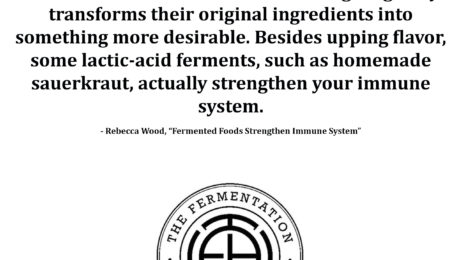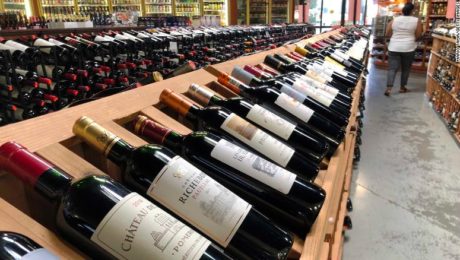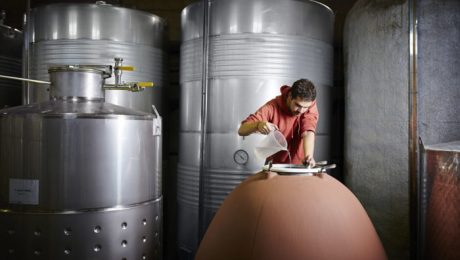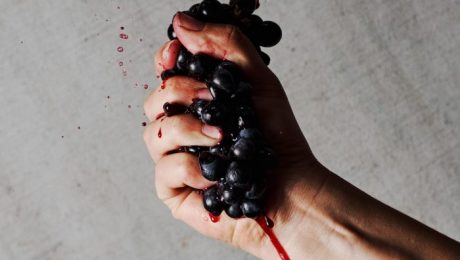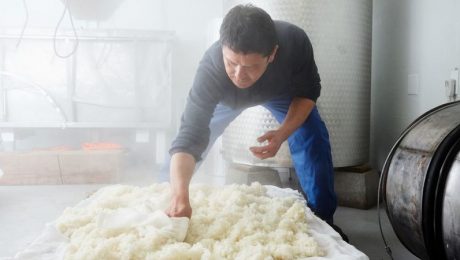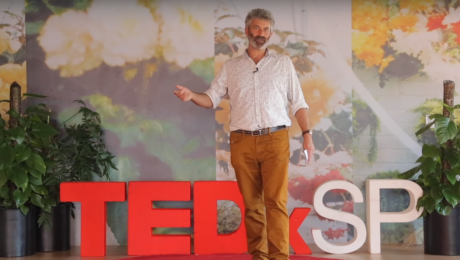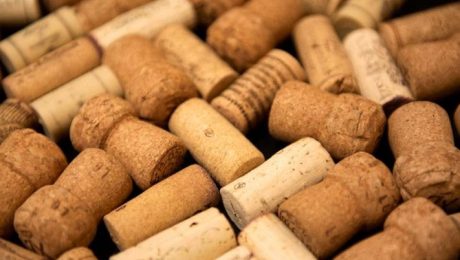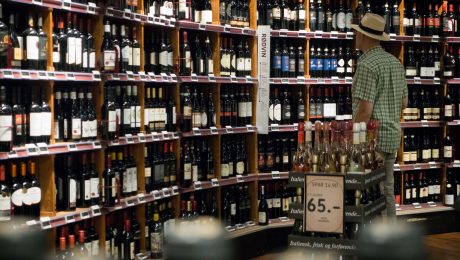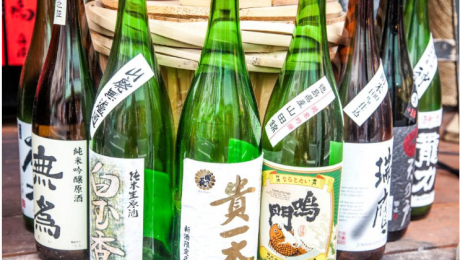Rebecca Wood on the Delicious Taste of Fermented Foods
“Why do some foods like chocolate, wine and cheese taste so delicious? Fermenting magically transforms their original ingredients into something more desirable. Besides upping flavor, some lactic-acid ferments, such as homemade sauerkraut, actually strengthen your immune system.”
Rebecca Wood, “Fermented Foods Strengthen Immune System“
- Published in Food & Flavor
Taxes on French Wine and Cheese Tabled Until 2021
A tax on imported French wine and cheese has been delayed until 2021. U.S. President Donald Trump and French President Emmanuel Macron agreed to hold off on potential tariffs until the new year. French products — like Le Creuset Dutch ovens, Hermès handbags, Roquefort cheese and French-made wine — would have been taxed. One wine importer told the news the potential tariffs were the greatest threat to the wine industry since Prohibition. Trump threatened the taxes in retaliation for a tax imposed in France on large American tech firms, such as Facebook and Google.
Read more (Wine Spectator)
- Published in Business
Does Wine Fermentation Vessel Matter?
Wine Enthusiast breaks down the different variety and sizes of vessels — and why winemakers use them. James Mantone, co-owner and winemaker at Syncline Wine Cellars, says: “It is really amazing to taste wines from different fermentation containers. They don’t even taste like they come from the same vineyards.” The magazine concludes winemakers do not prefer any particular vessel. They enjoy the creativity of changing vessels. Aryn Morell, owner/winemaker at Alleromb and Morell-Peña, and consulting winemaker for numerous wineries, says: “We probably move wine from vessel to vessel more often than people would think. It’s like, ‘Well, I liked the way it was in this egg in January, but in February it’s starting to get a little tense or a little reductive. Let’s move it.’ Now we’ll move it into a large format barrel, open the wine back up or visa versa.”
Read more (Wine Enthusiast)
- Published in Business
High-Tech Wine Fermentation Process Creates Fruity Flavor
Carbonic maceration is a high-tech wine-making technique invented in France in the 1930s. And it’s making a comeback today as more consumers crave fresher-tasting wines. From Wine Enthusiast: “Carbonic maceration can completely change a wine’s style and flavor profile. If you’ve ever tried a red wine that bounced brightly out of the glass with an ultra-fruity bubble-gum aroma or crunched lightly with cinnamon, vanilla and earthy, stemmy flavors, it’s likely you’ve encountered carbonic maceration.” In traditional wine making, the crashed grapes are transformed into alcohol by a yeast fermentation. Carbonic maceration involves adding whole, intact grapes and allowing the berries to ferment from the inside in an oxygen-free environment. The whole berries use CO2 added to the sealed vessel to break down sugars and malic acid to produce alcohol.
Read more (Wine Enthusiast)
- Published in Food & Flavor
Wine Label Resurrects Ancient Fermenting Techniques
Josko Gravner of Gravner Wines ferments deeply — he ferments his wine in large amphora, clay vessels that he buries outdoors. Gravner, who helped pioneer the wave of orange wines, runs a family cellar in northeastern Italy. He became “disillusioned with modern enology’s techniques” of conventional wines — like steel tanks in the cellar and chemical fertilizers in the vineyards. Gravner Wines is now an organic farm and very low tech, using a 1950s-era hydraulic basket press and ancient fermenting techniques. The wine is not only buried, it’s made using whole-cluster fermentation with the stems. Gravner finds whole-cluster fermentation in amphorae keeps the grape skins naturally submerged while still aerating the wine without manual punch downs.
Read more (Wine Spectator)
- Published in Business
Intricacies of Sake Maker’s Craft Featured in LA Times
In wine making, the grape is the critical element. The majority of the wine’s characteristics come from the grape. “But for sake making, it’s a little bit different. It’s more about technique, about people controlling the process,” says Yoshihiro Sako of Den Sake Brewery in California. Sako was featured in the Los Angeles Times Rice does not include natural sugars like grapes, so a sake brewer must add koji (a specialized fungus) to convert the rice’s starch into glucose, which then gets fermented into alcohol. Sako says weather conditions, too, can affect the flavor. His latest batches — made after the recent California rains — taste different than batches made during the change. Sako says it’s a way sake “expresses the locality.”
Read more (Los Angeles Times)
- Published in Food & Flavor
Sandor Katz on the Fermentation Phenomenon
It’s absurd to call fermentation a new food trend, says Sandor Ellix Katz, author of “The Art of Fermentation” and “Wild Fermentation.” Fermenting practices date back to early man. But, after decades of active pasteurization and a war on bacteria, fermentation is experiencing an awareness as a food phenomenon, Katz says.
Katz – who calls himself Sandorkraut, the fermentation revivalist – spoke at a TEDx Talk in Sao Paulo on wild fermentation and the power of bacteria. Coffee, bread, cheese, beer, wine – Katz points to these as examples of “the greatest delicacies that people around the world enjoy, products of fermentation that have never gone out of style and have not recently just come into style.”
No one needs to master biology or study microorganisms to practice fermentation, Katz stresses. Before microbiology became a field, fermentation historically was viewed as mysterious or mythical because no one understood the mechanisms of it. He adds: “I cannot find one single example of a culinary tradition anywhere the does not incorporate fermentation.”
Microbiology has illuminated and harmed fermentation. For decades, the information surrounding bacteria and microorganisms was negative. People were taught the dangers of bacteria and disease – and grew to fear fermentation. But discoveries in microbiology also found that everything we eat, plant and animal, is populated by microorganisms. All life is descended and created from bacteria.
“In a way, we’re bacteria super structures,” Katz said. “For the first time, from the scientific analysis, we began to understand that fermentation is the transformative action of microorganisms.”
Fermentation often gets a bad reputation because people consider fermenting the process rotten or spoiled food. But fermentation is manipulating environmental conditions to encourage the growth of good organisms and discourage the growth of bad organisms, Katz explains.
“Fermentation is making food that is more stable than the raw product of agriculture that we began with,” Katz says. “We’re creating something that is more delicious, we’re creating something that is more easily digestible, we’re creating something where some toxic compound in the food and the otherwise dangerous food is made safe.”
For the first time in history, science is revealing the benefit of eating the live bacteria in fermented foods. The prevalence of antibiotic drugs, antibacterial cleaning products and chlorinated water now kill all bacteria in food. This war on bacteria narrows the diversity of bacteria in our intestines, Katz points out.
“If they were to kill all those microorganisms, we couldn’t possibly exist because we rely on those microorganisms for our digestion, for our immune system, our ability to withstand disease our brain chemistry,” he says. “Yet this chemical exposure…narrows biodiversity that we have inside of us.”
Katz focuses his work on public education of fermentation, helping shed light on its safety and effectiveness. More people today are seeking fermented foods because of the growing recognition of the benefits fermentation, Katz says. He teaches that the greatest benefit of fermented products are the bacteria themselves. Eating fermented foods – foods that haven’t been cooked or heat processed, since that kills the bacteria – restores the biodiversity in our intestines.
“In addition to being this important mode of transformation of food and beverages which enables people to make effective use of the food resources that are available to them, fermentation is also an engine of social change. And all of us are the starter cultures,” Katz said.
- Published in Food & Flavor, Science
More Wine Brands Getting Rid of Cork-Topped Bottles
Could a cork-topped wine bottle become a thing of the past? Use of cork closures are down compared to 10 years ago as more brands opt for alternative closures. But bottle closures influence a person’s perception of a wine, according to three separate studies. Natural corks are still the preferred favorite and glass stoppers are considered an adequate replacement for luxury brands. Despite, more wine brands are using screw top closures – they’re on average .95 cents cheaper a bottle compared to cork and, after years in the cellar fermenting, show better than a cork-topped wine.
Read more (Forbes)
- Published in Business
Are There Really Carbs in Wine?
Short answer: it depends. Carbs come from the unfermented sugar that’s left over after the alcohol is produced. The amount of carbs will vary by brand, but dry wine has the lowest carb count.
Ilovewine.com shares details behind whether or not a glass of wine is safe for the health-conscious drinker. Wine only has roughly 2-5 carbs per glass, but multiple glasses can become a problem for anyone trying to maintain a healthy diet.
Read more at Ilovewine.com where this article was originally published. (Photo: Foodies Feed)
- Published in Food & Flavor
Sake Sommeliers Growing Mainstay in Restaurants
As sake becomes mainstream, more restaurants are hiring sake sommeliers. These sommeliers – who help pair the best sake with a meal – are educating diners about the fermented rice wine beverage. There’s a misconception that sake can only be served with Japanese food, but the wine and sake director of Zuma operations in the U.S. says: “Sake is becoming more than just a beverage for Japanese cuisine and we, as sake sommeliers, are looking to have sake displayed in all aspects of restaurant culture.”
Read more (Forbes)
- Published in Business

